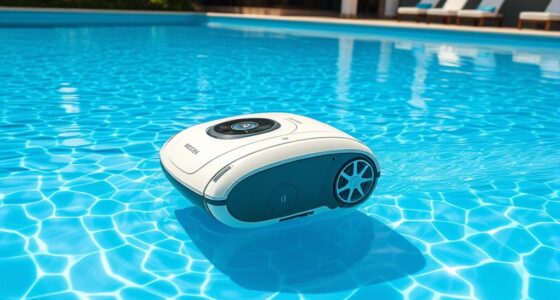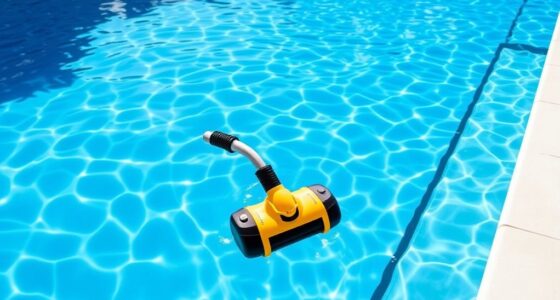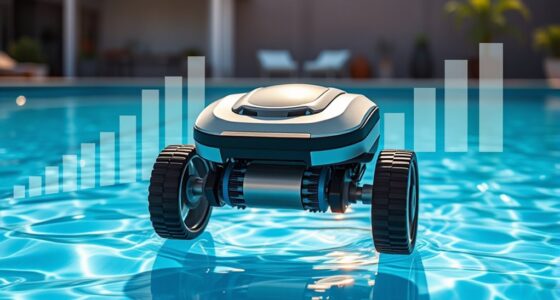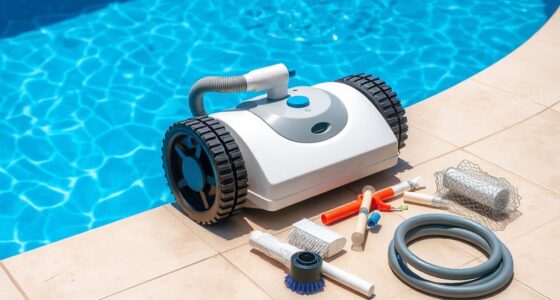To store your automatic pool cleaner for the off-season, start by cleaning and inspecting all parts for wear or damage. Drain water from hoses and components, then dry everything thoroughly to prevent rust and mold. Remove and clean the filter, check for worn parts, and replace if needed. Protect electrical connections from freezing temperatures with covers or storage containers. Maintaining these steps will guarantee your cleaner stays in top shape—up next, you’ll discover even more essential storage tips.
Key Takeaways
- Thoroughly clean and dry all components, including filters, brushes, and tracks, before storage.
- Disconnect electrical cords, inspect connectors, and apply dielectric grease to prevent corrosion.
- Drain all water from hoses, the cleaner’s body, and remove residual moisture to prevent freezing damage.
- Store the cleaner in a cool, dry, and well-ventilated area, elevated off the ground to avoid moisture exposure.
- Use waterproof covers or foam wraps to protect the device from dust, dirt, and temperature fluctuations during off-season storage.
Cleaning and Inspecting Your Pool Cleaner Before Storage

Before storing your pool cleaner for the off-season, it’s essential to thoroughly clean and inspect it. Start by ensuring the water chemistry and chemical balance are properly adjusted. Clean the brushes, filters, and tracks to remove dirt, debris, and any residual chemicals that could cause damage over time. Check for cracks, worn parts, or loose connections that might impair functionality later. Proper cleaning helps prevent mold, algae, and mineral buildup, which can affect performance. Make sure the cleaner’s components are dry before storage to avoid rust or mold growth. Additionally, inspecting your pool cleaner for wear and tear ensures all parts are functioning correctly and extends its lifespan. A thorough check for technological components can prevent unexpected malfunctions during the next season. Incorporating a routine maintenance schedule, including preventive maintenance, can further enhance the longevity of your equipment. Regularly inspecting equipment durability is also crucial for identifying potential issues early. Paying attention to water chemistry and keeping your cleaner in good condition helps prevent corrosion and deterioration, setting you up for an easier, more effective start when the season begins again.
Draining Water From the Pool Cleaner and Its Components

To prevent rust and mold growth during storage, it’s important to drain all water from your pool cleaner and its components. Start by removing water from all hoses, scooping out any residual water from the cleaner’s body. Use a towel or compressed air to assist with water removal from tight spaces and small openings. Focus on thoroughly drying each component to prevent moisture buildup. Proper component drying ensures no water remains that could cause corrosion or mold during the off-season. Check seals and joints for trapped water, and wipe them dry. Once all parts are dry, store the cleaner in a cool, dry place to further prevent moisture-related damage. Regularly inspecting filtration systems and ensuring they are dry can help maintain optimal performance and longevity of your pool cleaner. Additionally, paying attention to air circulation around stored equipment can reduce the risk of mold development. Incorporating proper storage techniques can also extend the lifespan of your pool cleaner. Ensuring proper water removal procedures and thorough drying is essential for preventing damage. Proper water removal and component drying are key steps to keep your pool cleaner in top shape until next season. Properly drying and storing your equipment can also prevent residual moisture from causing long-term issues.
Removing and Storing the Filter Cartridge or Bag

When you’re ready to store your pool cleaner for the off-season, removing the filter cartridge or bag is essential. Proper filter maintenance assures your cleaner stays in top shape. Carefully detach the filter, following your manufacturer’s storage techniques. Rinse away debris with a gentle stream of water to prevent mold and buildup. Dry the filter thoroughly before storage to avoid mold growth. Proper filter care can help extend the life of your filter. Storing your equipment in a temperature-controlled environment can further prevent damage caused by extreme temperatures. Using effective cleaning methods can prolong the life of your filter. Regularly inspecting and replacing damaged filters is crucial for maintaining optimal performance and longevity. Maintaining your equipment’s net worth through proper care ensures optimal performance and longevity. Keep it in a safe spot to prevent damage or contamination.
Checking and Replacing Worn or Damaged Parts

Before storing your pool cleaner, inspect all parts for signs of wear or damage. If you notice any broken or worn components, replace them with the correct parts to guarantee peak performance later. Using the proper replacements helps prevent issues when you’re ready to get back to cleaning. Regularly checking for worn or damaged parts can extend the lifespan of your equipment and ensure optimal functionality. Additionally, inspecting your equipment’s paint sprayer accessories ensures smooth operation when you resume use. Paying attention to material safety guidelines during inspection can help maintain the integrity of your pool cleaner’s components. Conducting regular maintenance checks aligns with candy storage best practices to keep your equipment in top shape and avoid unexpected breakdowns. Incorporating self-serve frozen yogurt options in your routine can also serve as a refreshing reward after maintenance.
Inspect for Wear and Tear
Regularly inspecting your pool cleaner for wear and tear is essential to keep it functioning efficiently during the off-season. Over time, components can degrade, affecting performance. Check hoses, brushes, and wheels for cracks, fraying, or brittleness, which indicate wear and tear. Look for any signs of leaks, loose fittings, or stiff moving parts that might suggest deterioration. Identifying these issues early prevents further damage and ensures your cleaner stays in good shape. Keep an eye out for soft or cracked rubber parts, as they’re more prone to breakage. Addressing component degradation now helps maintain the cleaner’s longevity and readiness for next season. Understanding industry trends can also help you anticipate common wear issues and perform targeted inspections. Incorporating proper storage techniques can further extend the lifespan of your pool cleaner and protect it from environmental damage. Remember, a thorough inspection ensures that minor issues don’t escalate into costly repairs later.
Replace Damaged Components
If you notice any signs of damage during your inspection, it’s essential to replace the affected parts promptly to prevent further issues. Damaged components like worn brushes or cracked casings can impair your cleaner’s performance. Pay special attention to the motor; if you experience unusual noises or motor troubleshooting becomes necessary, a replacement might be needed. Also, check the battery; if it no longer holds a charge, consider a battery replacement to restore power. Use the table below to guide your replacements:
| Part | Signs of Damage | Replacement Tips |
|---|---|---|
| Motor | Unusual noise, failure | Consult manufacturer, replace if faulty |
| Battery | Reduced run time | Ensure proper fit, replace if dead |
| Mechanical parts | Cracks, wear, or breakage | Use original parts for safety |
Replacing damaged components keeps your cleaner running efficiently during storage.
Use Correct Replacement Parts
When inspecting your pool cleaner, always verify that you’re using the correct replacement parts for any worn or damaged components. Using the right replacement parts guarantees your cleaner operates efficiently and reduces the risk of further damage. Follow your maintenance schedule closely to identify when parts need replacing, such as brushes, wheels, or seals. Avoid generic or incompatible replacement parts, as they can cause malfunctions or void warranties. Properly fitted parts help maintain ideal suction and movement, prolonging your cleaner’s lifespan. Before storage, double-check that all replacement parts are in good condition and installed correctly. This proactive approach minimizes issues when you restart your pool cleaner after the off-season, saving you time and preventing costly repairs.
Properly Cleaning and Drying All Parts
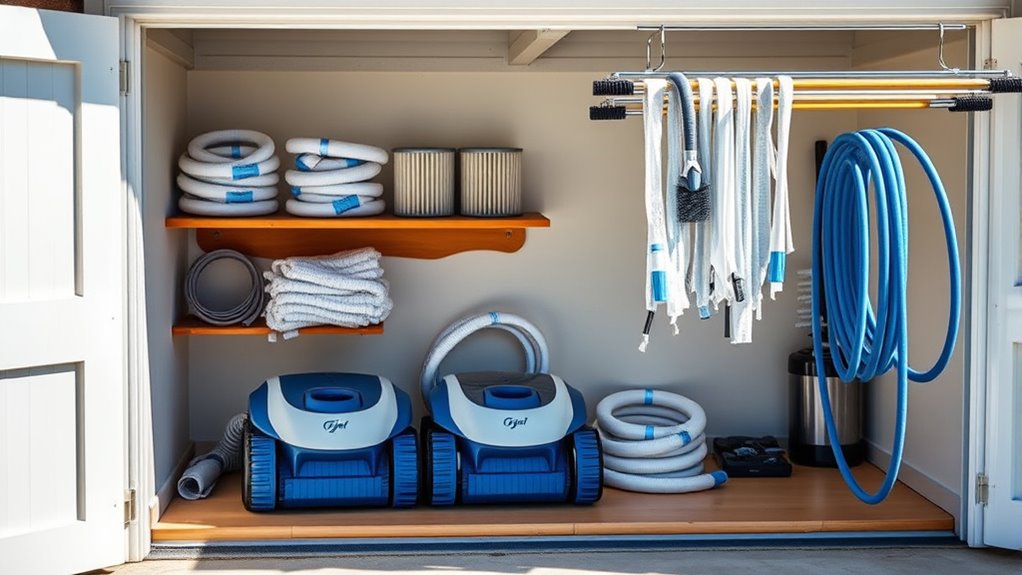
Before storing your pool cleaner, make sure to remove all debris thoroughly. Clean each component carefully to prevent buildup and damage. Finally, guarantee everything is completely dry to avoid mold and corrosion during storage.
Remove Debris Thoroughly
To guarantee your pool cleaner remains in top condition during off-season storage, you need to remove all debris thoroughly. Leftover dirt, leaves, or algae can damage internal components or cause mold growth if not cleaned properly. Check your pool cleaning schedule to ensure you’ve removed debris after the last use of the season. Also, consider your pool water chemistry; improper chemical balance can lead to residue buildup on the cleaner parts. Rinse all parts carefully, paying close attention to brushes, filters, and hoses. Removing debris completely minimizes the risk of corrosion or deterioration during storage. Once cleaned, dry each component thoroughly to prevent moisture-related issues. Proper debris removal now will help ensure your automatic pool cleaner stays in excellent condition until you’re ready to use it again.
Clean All Components
Ensuring all components are properly cleaned and dried is essential for maintaining your pool cleaner’s performance during storage. Start by rinsing each part with fresh water to remove any dirt, algae, or chemical residue. Check the water circulation system and clear out any blockages or debris to prevent mold or corrosion. Pay close attention to the brushes, wheels, and filters, making sure they’re free of buildup. Use a mild, non-abrasive cleaner if needed, and dry components thoroughly to prevent rust. Maintaining proper pool chemical balance before storage reduces the risk of corrosion or damage. When all parts are clean and dry, store them in a cool, dry place to keep everything in ideal condition for next season’s use.
Ensure Complete Drying
After cleaning all components, it’s important to dry each part thoroughly to prevent moisture buildup that can lead to rust, mold, or mildew. Proper drying is essential for effective moisture control and maintaining your cleaner’s longevity during storage. Confirm no water remains in any crevices or moving parts. Store your cleaner in a well-ventilated environment to reduce humidity and avoid mold growth.
- Wipe all parts with a clean, dry cloth
- Allow components to air dry completely
- Store in a cool, dry, and well-ventilated space
- Check for any remaining moisture before sealing the storage environment
Taking these steps helps protect your pool cleaner and ensures it’s ready for next season.
Storing the Pool Cleaner in a Suitable Location

Choosing the right storage location for your pool cleaner is essential for maintaining its performance and extending its lifespan. You should pick a dry, cool spot that’s protected from moisture and direct sunlight. Climate considerations are vital; avoid areas prone to high humidity or temperature fluctuations, which can damage internal components or cause mold growth. A well-ventilated shed, basement, or closet works best. Make sure the cleaner is stored away from chemicals or sharp objects that could cause damage. Keep it upright or in a position that prevents unnecessary strain on the device’s parts. Proper storage not only preserves the cleaner’s functionality but also makes it easier to set up for the next season. Always choose a location that’s secure and free from potential hazards.
Protecting the Device From Freezing Temperatures

When storing your pool cleaner during colder months, protecting it from freezing temperatures is a top priority. Freezing can cause damage to internal components, so you need to take precautions. Start by monitoring the temperature regularly with a thermometer to ensure it stays above freezing. Use insulation techniques, such as wrapping the device in foam or placing it in an insulated container, to shield it from cold air. Consider elevating the cleaner off the ground to prevent direct contact with cold surfaces. Additionally, drain all water from the device to reduce the risk of ice expansion. Implementing these steps helps prevent costly damage and keeps your pool cleaner ready for use when the weather warms.
- Use foam or bubble wrap for insulation
- Store in a heated or sheltered space
- Elevate the device off cold surfaces
- Ensure all water is drained before storage
Using a Cover or Container for Storage

Using a cover or container for storage provides an effective way to protect your pool cleaner from dust, dirt, and moisture during the off-season. Cover options include waterproof tarps, fitted pool covers, or specialized storage bags that keep debris out. These covers help prevent damage caused by environmental elements and keep your device clean. Containers, such as plastic bins or sturdy storage boxes, offer additional benefits by providing a secure and organized space for your cleaner. They prevent accidental damage and make it easier to locate and access your equipment when needed. Choosing the right cover or container guarantees your pool cleaner remains in good condition, ready for use when the swimming season resumes. Proper storage preserves the device’s longevity and performance over time.
Maintaining the Power Cord and Electrical Connections
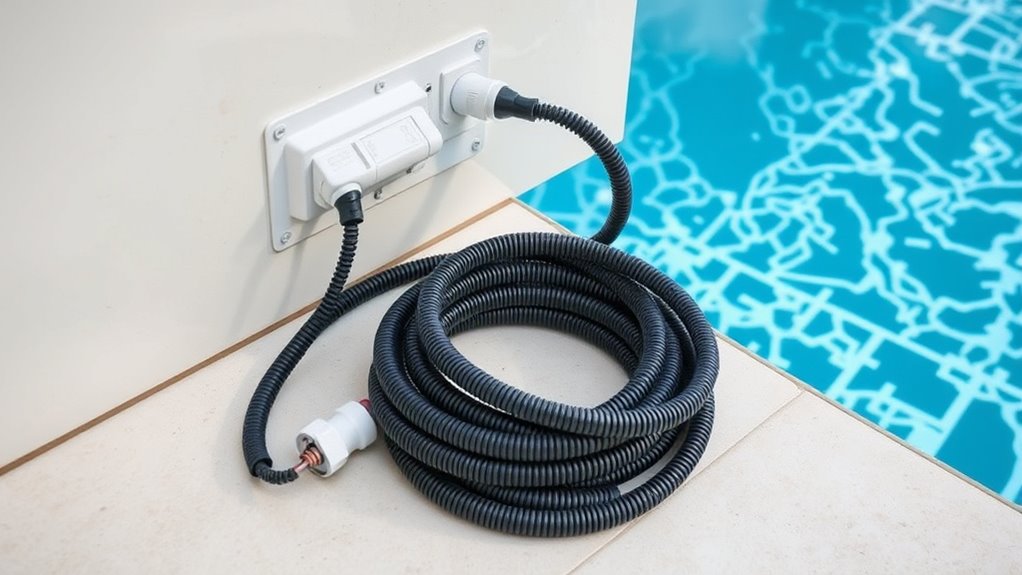
Make sure to check your power cord and electrical connections regularly for any damage or wear. Store the cleaner in a dry, protected area to prevent moisture from causing corrosion. Protect the electrical connectors with covers or caps to keep out dust and debris during off-season storage.
Inspect Cord Regularly
Regularly inspecting your pool cleaner’s power cord and electrical connections is essential to guarantee safe and efficient operation during the off-season. Proper cord inspection helps identify signs of wear, fraying, or damage that could compromise electrical safety. Make it a habit to check the entire length of the cord, paying close attention to the plug and connection points. Look for cracks, exposed wires, or corrosion, and ensure the connections are secure. Keeping your cord in good condition prevents electrical hazards and extends its lifespan. To stay safe and maintain ideal performance, regularly perform these checks:
- Examine for cuts, tears, or fraying
- Ensure plug connections are tight
- Look for corrosion or rust
- Test electrical safety features
Store in Dry Area
To prevent damage and guarantee safety, always store your pool cleaner’s power cord and electrical connections in a dry, sheltered area during the off-season. Proper dry storage helps protect components from moisture, which can cause corrosion and short circuits. Make sure the storage area is free from humidity, as excess moisture accelerates deterioration. Use a dedicated space that’s cool and well-ventilated to maintain ideal humidity control. Coil the power cord loosely to avoid kinks or stress on the wiring, and keep electrical connections off the ground to prevent accidental exposure to water. By ensuring your equipment stays dry and protected, you’ll extend its lifespan and maintain safe operation for next season.
Protect Electrical Connectors
Making certain your electrical connectors stay in good condition during storage is essential for safe and reliable operation. Properly protecting the electrical connections helps prevent connector corrosion and maintains electrical safety. Before storing, disconnect the power cord carefully and inspect all connectors for dirt or damage. Store connectors in a dry, protected area to avoid moisture buildup. Consider using dielectric grease on metal contacts to prevent corrosion. Use cable ties or clips to keep cords organized and prevent strain on connections. Regularly check the connectors during storage to catch any signs of corrosion or wear early. Proper maintenance not only prolongs the life of your pool cleaner but also ensures safety when you reconnect it next season.
Creating a Maintenance Checklist for Off-Season Care

Creating a thorough maintenance checklist is essential for properly caring for your pool cleaner during the off-season. Begin by reviewing your pool’s chemistry, balancing pH, alkalinity, and sanitizer levels to prevent corrosion or buildup. Adjustments may be necessary based on your seasonal climate—colder weather might require different chemical balances than warmer months. Next, clean the cleaner thoroughly, removing debris and rinsing all parts to prevent mold and mineral deposits. Check and lubricate moving parts, and inspect hoses and brushes for wear. Don’t forget to store batteries or electrical components properly. Document your steps to ensure nothing gets overlooked. A detailed checklist helps you maintain your cleaner’s condition and simplifies reassembly when it’s time to open the pool again.
Frequently Asked Questions
How Long Can I Leave My Pool Cleaner in Storage Without Using It?
You can typically leave your pool cleaner in storage for several months without issues, but proper maintenance is key. Make sure it’s thoroughly cleaned, dried, and checked for any damage before storing. Storage duration varies depending on the cleaner’s model and conditions, but generally, it’s safe to store it for up to 6 months if you follow proper maintenance steps. Regularly inspect it during storage to keep it in good working condition.
Can I Store My Pool Cleaner Outdoors During the Off-Season?
Storing your pool cleaner outdoors might seem like a small decision, but it can turn into a weatherproofing disaster! If you choose outdoor storage, make certain it’s in a truly weatherproof spot, like a sturdy shed or covered area. Protect it from rain, sun, and snow, because exposure can quickly turn your trusty cleaner into a rusty, useless mess. Always prioritize indoor or protected storage to keep your device in top shape!
What Are the Signs of Mold or Mildew on Stored Pool Cleaners?
You should regularly check your stored pool cleaner for signs of mold or mildew. Look for musty odors, fuzzy or dark spots, and discoloration on surfaces. To prevent mold, verify the cleaner is thoroughly cleaned and dried before storage. Good mildew detection involves inspecting all crevices and filters carefully. Proper mold prevention, like storing in a dry, well-ventilated place, helps keep your cleaner in good shape for next season.
Is It Necessary to Lubricate Parts Before Storing the Cleaner?
Did you know that proper storage can extend your pool cleaner’s lifespan by up to 30%? For storage preparation, it’s essential to meet lubrication requirements; this prevents parts from corroding or sticking during inactivity. You should lubricate moving parts before storing your cleaner to ensure smooth operation later. Skipping this step can cause damage, so always follow manufacturer guidelines for lubrication requirements during off-season storage.
How Often Should I Check Stored Pool Cleaners During the Off-Season?
You should check your stored pool cleaner at least once a month during the off-season. Keep it in a secure storage container and follow a simple cleaning schedule to prevent mold or damage. Regular inspections ensure the cleaner remains in good condition, and you can catch any issues early. This routine helps maintain your equipment’s longevity and readiness for use when swimming season returns.
Conclusion
By following these off-season storage tips, you’ll guarantee your pool cleaner remains in pristine condition, ready to conquer the next swimming season. Proper care prevents costly repairs and keeps your device performing like a well-oiled machine—almost like it has a secret life beyond your pool. Treat it with care, and it’ll reward you with effortless cleaning and endless summer fun, making your pool the envy of every backyard oasis.


